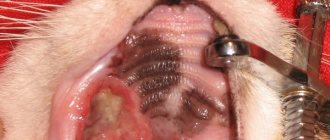Bronchitis in cats is an inflammatory process that occurs on the mucous membranes of the bronchi. Often this inflammation can also affect the trachea. This disease occurs primarily in weakened pets, or appears secondary to other diseases. In this article we will look at the causes of bronchitis, the characteristic symptoms and dangers of this disease, as well as methods for its treatment.
What is bronchitis in cats?
A cat of any age can get bronchitis, but weakened pets mostly get sick.
Table 1. Classification of bronchitis according to the course of the disease
| Types of bronchitis | Description |
| Spicy | A sharp inflammatory process, one of the forms of diffuse damage to the bronchial tree |
| Chronic | A progressive inflammatory disease of the respiratory system that disrupts the protective and cleansing function of the bronchi |
Table 2. Classification of bronchitis by damage to the bronchi
| Types of bronchitis | Description |
| Macrobronchitis | The inflammatory process spreads in the large bronchi |
| Microbronchitis | Inflammation of the small bronchi |
| Diffuse | Inflammation of the entire bronchial tree |
Differences between healthy bronchi (right view) and inflamed bronchi with bronchitis (left view)
Table 3. Classification of bronchitis by type of inflammation
| Types of bronchitis | Description |
| Catarrhal | Inflammation of the mucous membranes of the respiratory system |
| Fibrinous | Inflammation with a high content of fibrin in the bronchial secretion - fibrous protein or blood |
| Purulent | Inflammatory changes in the bronchial tree with discharge of purulent secretions |
| Putrefactive | A form of chronic bronchial inflammation, which is accompanied by the development of putrefactive flora |
| Hemorrhagic | Inflammation with bleeding, decreased blood clotting |
Table 4. Classification of bronchitis by origin
| Types of bronchitis | Description |
| Primary | Inflammation of the bronchi, spreading to the entire bronchial tree |
| Secondary | Inflammation complicating another respiratory disease |
If your cat develops gurgling sounds in the chest area, difficulty breathing with wheezing, or coughing, take her to a veterinary clinic immediately.
Mechanism of disease development
The disease originates from damage to the bronchial mucosa, producing an irritating and inflammatory effect with the release of fluid, which begins to accumulate in the tissues of the respiratory system. As a result, the mucous membrane succumbs to a strong irritant effect and coughing, swelling appears, and exudate provokes shortness of breath.
What other diseases can be diagnosed when a cat coughs ? Read about this in our article.
During chronic bronchitis, the mucous membrane is completely exposed to the harmful effects of microbes, and along with it, inflammation of the bronchial wall occurs. As a result, muscle fibers are replaced by connective tissue cells, causing the bronchi to lose elasticity and contractile function.
Causes
The main causes of bronchitis in cats are:
Non-infectious:
- Hypothermia of the animal (being in drafts, washing in too cool water, excessive exposure to rain or sleet, absorption of frosty or cold air, being on a chilled surface - ground, concrete, tiles).
Hypothermia can cause bronchitis
- Vitamin deficiency - a lack of essential vitamins weakens the immune system, resulting in illness.
- Inhalation of vapors of hazardous chemicals (tobacco smoke, household chemicals).
- Allergic reaction (dust, pollen from indoor plants, medications).
Infectious in nature: damage to the body by parasites (toxocariasis, hookworm), fungi, bacteria, viruses. Inflammation of the bronchi is provoked by parainfluenza viruses, rhinotracheitis, and adenoviruses. A large number of tissues become infected, so diagnostics are indispensable.
Path of infection of a cat with toxocariasis
What do you need to know? If your cat does not have proper nutrition, it may develop bronchitis. A balanced diet and consumption of essential vitamins strengthens the cat’s immune system and allows the body to fight infections.
Laryngitis
Laryngitis (inflammation of the laryngeal mucosa) is divided by origin into primary and secondary, by course - into acute and chronic, by the type of exudate - into catarrhal and croupous. In acute catarrhal laryngitis, superficial inflammation of the mucous membrane of the larynx is noted, in chronic - deeper layers with significant; morphological changes.
Etiology
Laryngitis occurs when a cat is exposed to a draft for a long time, in dampness, eating frozen meat, exposed to harmful vapors, gases, overstraining the vocal cords, as well as with some infectious and non-infectious diseases. Laryngitis can develop due to inept, forcible insertion of a feeding tube.
Pathogenesis
The above etiological factors irritate the nerve elements of the larynx, resulting in inflammation of the mucous membrane and a general reaction of the body. The inflammatory process is accompanied by cough, hyperemia and swelling of the mucous membrane, separation of exudate, rejection of the epithelium and the appearance of hemorrhage.
Symptoms
Sick animals are depressed, their appetite is reduced, cats lie more with their necks stretched forward. During palpation of the tissues of the retropharyngeal space, cough and soreness appear. In acute laryngitis, the general temperature is normal, in catarrhal - the listed symptoms are more pronounced, body temperature is increased by 1 - 1.5 ° C. Pulse and breathing are increased.
We suggest you read: What to do if your cat has a fever
Diagnosis
Diagnosed on the basis of anamnesis and examination of the animal (Fig. 15, 16). The nature of the inflammatory process is clarified using the laryngoscopy method. It is necessary to exclude infectious diseases. The prognosis is favorable to cautious. The cat may die from asphyxia.
Treatment
It is necessary to eliminate the cause of the disease. Proper conditions are created for the animal, eliminating dampness, drafts and dust in the room. Patients are not bathed; food is given warm. Warming compresses are applied to the larynx area. Medicines prescribed include expectorants, disinfectants, antibiotics, sulfonamide drugs, UHF, diet therapy can be used, and in case of asphyxia, tracheotomy.
To treat laryngitis, ammonium chloride, codeine phosphate, ipecac root, coltsfoot leaf, plantain leaf, anise fruit, ammonia-anise drops, dill fruit, terpin hydrate, thermopsis or thyme herb are used. To treat the surface of the laryngeal mucosa, a 0.2% solution of silver bdaterate, a 3% solution of protargol, a 0.02% solution of furatsilin, a 1.5-2% solution of chloramine, a 1% solution of iodinol are prescribed. L.1% solution of potassium permanganate.
Symptoms
Early detection of signs of bronchitis will prevent the spread of the disease, which can spread to the lungs with serious consequences, for example, the pet will get pneumonia.
Common symptoms of the disease:
- Cough, which can be dry or immediately with sputum, accompanied by a whistling sound. It is very difficult to detect the presence of a cough because in cats it sounds like sneezing or gagging.
- Hypoxia, which occurs with severe coughing and lack of oxygen. Often accompanied by blue discoloration of the gums and oral mucosa.
- Vomiting. They can be caused by an excessively strong cough.
- Rhinitis, conjunctivitis, enlarged lymph nodes.
- Loss of appetite occurs during intoxication of the body.
- Lethargic, weakened state of the pet.
- Fever and chills.
- Disorder of the digestive system due to viral infection.
Bronchitis can lead to pneumonia
Prevention
In order to prevent your pet from getting sick, you need to regularly carry out preventive work, which is actually not as difficult as it seems. You can avoid many diseases, including bronchitis, by following simple rules:
- make sure that the cat does not become overcooled;
- eliminate drafts;
- make your pet a warm bed or buy houses so that the cat does not sleep on the cold floor.
- place the sleeping area away from doors and windows, which can be sources of drafts;
- feed your pet a balanced diet enriched with the necessary vitamin and mineral complex;
How to feed a cat natural food?
- give water only at room temperature;
- Make sure that your pet does not have access to household chemicals and do not spray aerosols harmful to your pet in the room;
- carry out weekly cleaning with a damp cloth;
- do not bathe your cat during the cold season;
- Avoid keeping your pet out in the rain or wet snow.
What do you need to know? The most common respiratory disease in cats is bronchitis. If you notice symptoms indicating the presence of a disease in your pet, immediately show it to a specialist in order to begin treatment on time.
The cat should have a specially designated place, located in a warm, dry place without drafts, preferably soft bedding or a house
Description of the pathology
Bronchitis can be acute and take a chronic form.
The acute course of the pathological process is usually caused by pathogenic microorganisms or viruses. The disease takes a chronic course with untreated or untreated acute bronchitis or with prolonged exposure to irritating factors on the bronchial mucosa (dust, allergens, aggressive substances in small doses). As a result of swelling of the mucous membrane, the animal’s breathing becomes difficult, the amount of air entering the breathing system, and, as a result, to the organs and tissues decreases. Mild hypoxia may develop.
The causes of the disease are: bacteria, viruses, mechanical and chemical irritants.
Factors contributing to the development of pathology include any conditions and situations that help reduce the reactivity of the cat’s body:
- hypothermia;
- stress;
- helminthiases;
- dietary errors (hypo-, avitaminosis, lack of minerals);
- smoking in the presence of an animal;
- active use of perfumes;
- household chemicals that have entered the pet’s respiratory tract;
- smoke containing irritating substances.
Long-term chronic diseases of a cat, especially an older one, can also become a factor provoking problems with the respiratory system. For example, congestion in the pulmonary circulation caused by cardiovascular diseases.
With this pathology, the animal develops a characteristic cough.
- dyspnea;
- cough, during which you can hear a whistle;
- change in the shade of mucous membranes to blue;
- drowsiness;
- weakness;
- loss of appetite;
- mucous discharge from the nasal passages;
- increase in body temperature.
If appropriate treatment is not given, the disease progresses and causes more severe symptoms. Squelching in the bronchi develops, the cough becomes wet, and sputum is produced. There is a severe runny nose, but the temperature may return to normal. When a cat coughs a lot, there is a possibility of vomiting.
It is very important to notice the first signs of the disease in time in order to begin treatment as soon as possible. If you do not start treating your cat promptly, the disease can spread to the lungs and cause pneumonia. That is why, in order to keep your pet healthy, you need to know the basics about bronchitis in cats - symptoms and treatment.
It is very important for the owner not to ignore the animal’s first symptoms
Signs of the disease:
- Severe cough with whistling, which exhausts the animal.
- Increased temperature (indicates the viral nature of the disease).
- Decreased appetite (occurs due to intoxication of the body).
- Runny nose
- With an allergy that provoked the disease, tearing, nasal discharge, sneezing, and swelling of the muzzle are observed.
- If bronchitis was caused by a viral infection, the pet may suffer from stool upset.
- The animal looks tired, moves little and sleeps a lot.
Quite often, cat owners do not perceive bronchitis as a serious illness. They attribute the pet's cough to dust getting into the body, or something else. However, at the first signs of illness, it is recommended to show the animal to a veterinarian to rule out serious diseases and prescribe medications (if necessary).
Bronchitis in cats is a rather unpleasant inflammatory disease. Today we will tell you everything a responsible owner needs to know about this disease. Let's start with the causes of the development of the disease, then we will discuss the symptoms and methods of treating cats for bronchitis at home.
What is bronchitis?
Bronchitis is an inflammation of the mucous and submucosal layer of the bronchi. The danger of this disease lies in the fact that the inflammatory process easily “descends” to the lungs.
But fighting pneumonia is much more difficult.
That is why it is so important for owners to know the symptoms of bronchitis in cats in order to recognize this disease in time, as well as immediately begin competent and effective treatment.
But before you deal with the signs of bronchitis, you should study what causes the development of the disease exist. This knowledge will help you avoid risks.
To understand how to cure bronchitis, you first need to understand its causes - there are not so many of them.
Symptoms
Symptoms of bronchitis in cats are difficult to miss. We have structured them in as much detail as possible so that the diagnosis can be made as accurately as possible.
Cough
The first symptom of bronchitis in a cat is a cough. Most likely, it will be dry at first, but it is possible that there may be phlegm. If you squeeze your throat a little, the cough intensifies. But, of course, even if you put pressure on a healthy animal’s trachea, it will start coughing. In cats, it’s difficult to figure out whether she’s sneezing or coughing, or whether she’s starting to vomit.
Hypoxia
Due to the strong cough, there is not enough oxygen. And then hypoxia develops - lack of oxygen. The owner will probably notice a bluish tint to the mucous membranes (raise your upper lips and see the gums turn blue).
Other symptoms
Other signs of bronchitis in cats:
- Vomit. Sometimes vomiting occurs due to a very strong cough. Therefore, it is worth distinguishing when a cat is really vomiting, and when vomiting is just a consequence of a coughing attack.
- Rhinitis, conjunctivitis, enlarged lymph nodes, fever. If the cause lies in an adenovirus, then sniffles will be added to the cough already described above, and nearby lymph nodes will enlarge and become painful. Fever is noted. Sometimes conjunctivitis is recorded. Vomiting and diarrhea also accompany adenovirus.
- The pulse quickens, and the frequency of respiratory contractions increases (after all, there is not enough oxygen, you have to breathe more).
- Body trembling appears.
- Appetite disappears.
- And the pet itself becomes very lethargic.
If you have identified several symptoms of bronchitis in your cat, then it’s time to contact your veterinarian for treatment.
This is what the symptoms of bronchitis in cats look like (see video)
Treatment
Treatment of bronchitis in cats should begin as early as possible.
But the whole problem lies in the fact that if you don’t know what exactly is the cause of this illness in your pet, then it is simply impossible to choose a competent and effective treatment regimen.
After all, it must be comprehensive and always aimed at eliminating the causes of the disease. Symptomatic therapy only temporarily alleviates the condition, but as soon as it is stopped, bronchitis and other symptoms will return.
Is the reason due to the irritating air? Ventilate the room, do a wet cleaning of the house. Eliminate all possible allergens! Antihistamines may be prescribed.
How to treat bronchitis in a cat? If the cough is dry, then a drug must be prescribed that will help form sputum (licorice, coltsfoot - excellent herbal ingredients).
Once it appears, other drugs are needed to remove it from the respiratory tract. Therefore, it is worth understanding that each type of cough requires its own drug.
And you should not give medicine for a dry cough for a wet cough, and vice versa.
You cannot do without antibiotics for bronchitis in cats, even if the causes are non-infectious, because bacteria can “attack” a weakened body. The course of treatment is at least 7 days (preferably 10).
But it’s also worth remembering that an allergic cough will not disappear, even if you inject your pet with the most “powerful” antibiotics.
Bronchitis in cats is an inflammatory process that occurs on the mucous membranes of the bronchi. Often this inflammation can also affect the trachea.
This disease occurs primarily in weakened pets, or appears secondary to other diseases.
In this article we will look at the causes of bronchitis, the characteristic symptoms and dangers of this disease, as well as methods for its treatment.
Reasons for appearance
Veterinarians say that before paying attention to the causes of bronchitis, a pet owner should know the reasons why a cat might get bronchitis. The disease is believed to be caused by pathogenic microorganisms.
The causative agent of this form of the disease can be the following pathogenic infections:
- bacteria (the most common are pneumococci);
- viruses;
- fungi;
- rickettsia.
These microorganisms can cause not only primary bronchitis, but also secondary. Often, owners encounter inflammatory processes in their pets as secondary ones when cats become ill with parainfluenza, rhinotracheitis or adenoviral infection. Against the background of these viral diseases, cats develop bronchitis, the corresponding symptoms and treatment of which will be described below.
We suggest you read: Feeding cats with natural products. What vegetables can you give your cat? Vegetables and fiber in a cat's diet
Infection of cats with parasitic insects is also considered an infectious form of the disease. Some of them (for example, toxocara, hookworms) entering the upper respiratory tract of animals can cause inflammation of the mucous and submucous membranes of the bronchi.
Non-infectious causes of this disease in pets can include:
- Allergenic substances. Such allergens may include: pollen from flowering indoor plants, dust accumulating in the apartment, toxic chemicals used indoors and outdoors, and medications. It is these substances that most often cause inflammation of the bronchial tree.
- Aerosols. All kinds of aerosol preparations can irritate the mucous membranes of the bronchial tree. Such preparations include: household aerosol preparations, perfumes and other sprays, paints and varnishes, solvents, and other toxic emissions.
- Smoke. Cigarette and other smoke in the room where cats are located can lead to the development of chronic bronchitis in them. This happens because smoky air constantly irritates the bronchi.
- Heart diseases. Diseases of the heart and blood vessels, which are characterized by stagnation of blood in the pulmonary circulation, can lead to the development of a chronic form of bronchitis (most often in old individuals).
- Hypothermia. When animals do not have their own home, or those pets that constantly go outside (including during the cold season) are more likely to develop bronchitis.
What is bronchitis?
Why is bronchitis dangerous?
If the disease passes in a latent form and is not diagnosed in time, then it is very dangerous and can threaten the life of the pet. Often, chronic bronchitis can trigger asthma in a cat. If the inflammatory process of the respiratory mucosa is not treated for a long period of time, then bronchoconstriction and then asthma develop. The danger is that inflammation easily spreads to the lungs, leading to pneumonia, a more dangerous and difficult-to-treat disease. Therefore, if the slightest symptoms of bronchitis are detected, it is necessary to show the cat to a veterinarian and begin therapy as quickly as possible.
Why is it developing?
The following pathogenic microorganisms can provoke the occurrence of this disease in cats:
- bacteria;
- viruses;
- mushrooms;
- rickettsia.
They can cause not only primary pathology, but also secondary one. If we are talking about the second type, then such bronchitis can occur with parainfluenza or adenoviral infection. In addition, infectious pathology can also be caused by parasitic insects that enter the upper respiratory tract of cats and cause the development of inflammatory processes.











